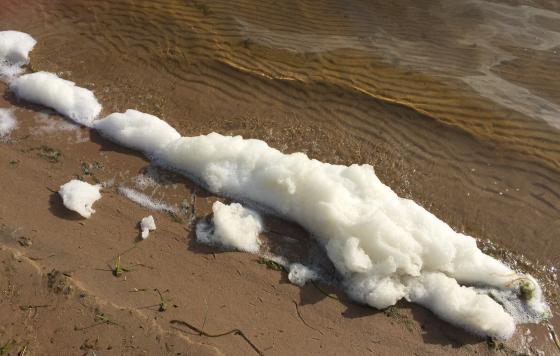What are PFAS?
The acronym PFAS stands for per- and polyfluoroalkyl substances, which is a class of thousands of different human-made chemicals that contain carbon-fluorine bonds. PFAS chemicals are notable because those carbon-fluorine bonds are particularly strong and hard to break—meaning that PFAS are very resistant to degradation and have long lifetimes. When PFAS get released into the environment, they can be transported hundreds of miles, contaminating our soil, water supplies, and even our bodies.
PFOA, one type of PFAS chemical, is found at low levels in the blood of most Americans.
PFOA (perfluorooctanoic acid) and PFOS (perfluorooctanesulfonic acid) are two PFAS chemicals that have gotten a lot of public attention. These two specific chemicals have mostly been phased out in the US due to an increased awareness of their harmful effects. Unfortunately, many manufacturers have just switched to newer types of PFAS chemicals for the same applications, and these newer versions are just as persistent in the environment, still difficult to remove from water, and just as toxic.
What are their health effects?
- Early studies have shown that PFOA causes cancer, PFOS disrupts thyroid hormones, and both can affect the immune system and reduce infant birth weights.
- A recent study released by the US Agency for Toxic Substances & Disease Registry (ATSDR) found that PFAS were more harmful than previously thought, and that “safe levels” were 10 times lower than previously thought. Potential health effects identified in this study include liver damage, increases in cholesterol levels, increased risk of thyroid disease, asthma, and infertility, decreased response to vaccines, riskier pregnancies, and decreases in birth weight.
What are they used for, and how does contamination occur?
Many types of firefighting foam are made from PFAS chemicals, and their use at airports, factories, and military sites is a major source of soil and groundwater contamination. Additionally, PFAS are often used in firefighting clothes and equipment, which poses a serious health risk to the firefighters that use them.
PFAS chemicals have been widely used in consumer products since they were discovered in the 1950s, as they're very water-resistant. While we don't know the true extent of PFAS use in consumer products, some common applications include non-stick cookware, water- and grease-resistant food packaging, water-repellent clothing and outdoor gear, stain resistant fabrics and carpets, and waterproof cosmetics like mascara.
Regular use of consumer products, and improper disposal of them, is a major route through which PFAS gets into our bodies and the environment. For example, food packaging containing PFAS, like pizza boxes and microwave popcorn bags, can potentially transmit the chemicals to the food itself before we eat it.
Manufacturing facilities are another potential source for environmental and human exposure. Waste from facilities using PFAS or making products containing them can be illegally released into the environment, and people who work at these facilities often show higher amounts of the chemicals in their bodies.
PFAS pollution has been documented at 94 sites in 22 states (including industrial plants, military bases, airports and fire training sites) and in the tap water of up to 16 million people in 33 states.
What can be done?
We need better tools to better understand where these chemicals are present in our environment and in our drinking water sources. We need to know where these chemicals are made and used, and which products they're being used in. We also need to identify the different ways they are getting into the environment and the best methods to stop that contamination. We need better information on effects on our health, on wildlife, and on overall environmental quality.
Additionally, the costs of clean up should not be paid by taxpayers, but by those responsible for the contamination. Producers of these chemicals need to be held accountable for contamination, and for continuing to make and use these chemicals while withholding evidence of health risks.
State and federal governments are able to act on this issue. The government's response should include:
- Increasing drinking water testing across the country,
- Identifying and disclosing where PFAS are manufactured and where releases to the environment are occurring,
- Setting disclosure requirements for when PFAS are used in food packaging and other consumer items,
- Increasing research into human health risks,
- Increasing investment in developing robust laboratory methods to test for PFAS in drinking water, wastewater, and soil samples,
- Increasing investment in research on treatment to remove PFAS in drinking water and at toxic sites,
- Setting new standards for composition and use of fire fighting foams, including eliminating requirements to use PFAS in training exercises, and
- Using all available authority to control and remediate releases into the environment.
What Clean Water Action is doing:
- Educating policymakers and the public about the risks of PFAS chemicals, how they are used, solutions, and the need to hold polluters accountable,
- Focusing on drinking water impacts and identifying research needs, impacts on public water systems, and Safe Drinking Water Act responses to protect public health,
- Identifying ways to stop releases including stopping the use of these chemicals, through pollution control programs under Clean Water Act, and using other programs,
- Working with impacted communities — those with contaminated soil, wells, or water sources — to support their efforts to hold polluters accountable, to get water treatment or new water sources, health monitoring, and clean up of contaminated sites,
- Working on state regulation and legislation to tell consumers when PFAS is in food packaging and consumer products, to curb their use, stop contamination of water, and hold polluters accountable, and
- Supporting Safe Drinking Water Act programs to monitor PFAS in drinking water, develop accessible testing and treatment technologies identify health protective drinking water standards, and educate consumers about what they can do to protect themselves and their families from PFAS in drinking water.
PFAS Resources:
Revised November 24, 2025.



